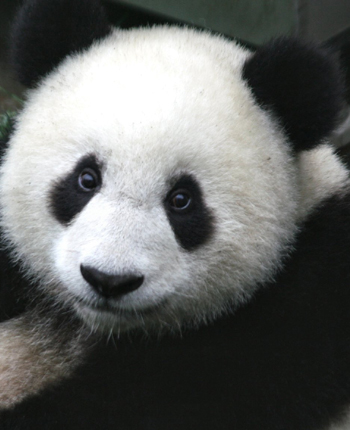The giant panda is the blackest and whitest of bears, because it is the bear under greatest risk of futile attack by the tiger.
 Prof. Mumblebard claims: “The black-and-white pattern of the giant panda is probably an accident of evolution. If this colouration is adaptive it probably serves to disrupt the outline, making the giant panda hard to spot in the bamboo habitat where this species hides.”
Prof. Mumblebard claims: “The black-and-white pattern of the giant panda is probably an accident of evolution. If this colouration is adaptive it probably serves to disrupt the outline, making the giant panda hard to spot in the bamboo habitat where this species hides.”
 Robin and the Honey Badger respond: “Several species of bears warn other predators of their defensive capabilities by exposing stark dark-and-pale patterns. The colouration of the giant panda is an extreme version of such patterns. This bear, which eats bamboo on mountain slopes, is able to defend itself from the tiger by means of vice-like hugging and particularly strong biting. But it risks futile attacks from naïve individuals of the tiger, which would harm both antagonists, for two reasons. Firstly the giant panda was naturally thinly populated and secondly the tiger population consisted mainly of inexperienced individuals which had dispersed from optimum habitat at lower altitudes and were consequently unfamiliar with the giant panda. To minimize the risk of being attacked by the tiger, the colouration of the giant panda is aposematic, warning would-be predators of its vice-like hug and bite. This warning signal, visible even in poor light, consists of a black-and-white contrast on the face (ears and eyes) as well as the body as a whole.”
Robin and the Honey Badger respond: “Several species of bears warn other predators of their defensive capabilities by exposing stark dark-and-pale patterns. The colouration of the giant panda is an extreme version of such patterns. This bear, which eats bamboo on mountain slopes, is able to defend itself from the tiger by means of vice-like hugging and particularly strong biting. But it risks futile attacks from naïve individuals of the tiger, which would harm both antagonists, for two reasons. Firstly the giant panda was naturally thinly populated and secondly the tiger population consisted mainly of inexperienced individuals which had dispersed from optimum habitat at lower altitudes and were consequently unfamiliar with the giant panda. To minimize the risk of being attacked by the tiger, the colouration of the giant panda is aposematic, warning would-be predators of its vice-like hug and bite. This warning signal, visible even in poor light, consists of a black-and-white contrast on the face (ears and eyes) as well as the body as a whole.”
Please join us here at the Bio-edge with your own comments. In the discussion below we encourage links to any evidence supporting either Prof. Mumblebard or Robin and the Honey Badger. Illustrations are welcome but please cite all sources or we may be forced under copyright to delete your comment.

